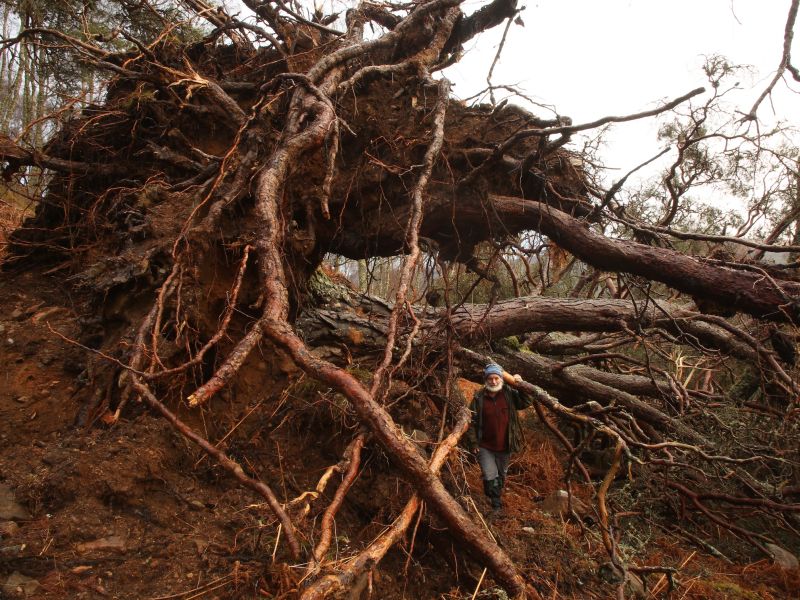With thanks to Richard Bunting.

Trees for Life’s Alan Watson Featherstone with a giant Scots pine recently uprooted by severe storms at Dundreggan Conservation Estate
Concerted action is needed to ensure a secure future for the Scots pine, which last week was declared Scotland’s national tree, leading conservation volunteering charity Trees for Life said today.
The charity – which played a key role in the campaign that led the Scottish Parliament on 30 January to name the Scots pine as the country’s national tree – is warning that higher priority must be given urgently to the conservation of Scotland’s pinewoods.
Trees for Life’s Executive Director Alan Watson Featherstone said:
“Declaring the Scots pine – bastion of the Caledonian Forest and one of the world’s most beautiful trees – as a national symbol sends a signal to the world that Scotland values its trees as an important part of its culture and identity. But with alarm bells ringing for this remarkable tree’s future, we should strengthen conservation action now.
“Our national tree is under siege from climate change, extreme weather and disease. We owe it to future generations to ensure its long-term survival by being world leaders in reforestation.
“We call on the Government to use the upcoming revision to the Scottish Rural Development Programme – the principal funding stream for forest schemes in Scotland – to ensure that support for native pinewood restoration is maintained and enhanced.”
This winter’s severe storms have highlighted the vulnerability of even well-established Scots pines to extreme weather, something that is likely to increase with climate change – and also the lack of young trees to replace mature specimens when lost.
During the unusually powerful storm that struck north Scotland on 5-6 December 2013, several giant Scots pines at Trees for Life’s Dundreggan Conservation Estate near Loch Ness were uprooted and blown over, and others badly-damaged. Some of these trees were probably more than 200 years old. Some ancient pines were also lost in the Glen Affric National Nature Reserve.
Such losses are part of a forest’s natural cycle, creating light gaps where new life can begin, and trees will eventually grow there again. Yet the full process will take decades or more, and it will be at least 200 years before trees comparable to those lost reach maturity. Loss of habitat provided by large mature pines can have a significant impact on biodiversity, as species that are dependent on old trees have nowhere else to live.
this disease has affected Lodgepole and Corsican Pine in Scotland
This also highlights the lack of young or even 100-year-old pines to replace mature trees and so ensure the survival of Scottish pinewoods. Overgrazing by sheep and deer for two centuries has prevented natural regeneration of native pinewoods throughout the Highlands.
In a healthy forest ecosystem, deer numbers would be in balance with regenerating trees – but imbalances in the Highlands landscape have created a 200-year generation gap for Scots pines. Until fencing and conservation-oriented deer culling began in the last two decades, there were no trees younger than 150 years in most locations.
Another potential threat is Dothistroma Needle Blight. Also known as Red Band Needle Blight, this disease has affected Lodgepole and Corsican Pine in Scotland. The Scots pine was believed to have low susceptibility to the disease.
However, the Forestry Commission has noted an increase in the distribution and severity of the disease on Scots pine, particularly in Scotland, although it isn’t yet known whether this will lead to tree mortality or extend significantly into the Caledonian pinewoods.
Fortunately, active restoration measures are underway for many of Scotland’s best pinewood remnants. Trees for Life itself has planted more than one million trees at dozens of sites in the Highlands, and has pledged to establish one million more trees by planting and natural regeneration by 2018. Such positive actions need to be developed and enhanced.
Scots pine, formally known as Pinus sylvestris, is the largest and longest-lived tree in the Caledonian Forest, forming a ‘backbone’ in the forest ecosystem on which many other species depend.
The tree provides a home for wildlife including red squirrels, capercaillie and crossbills; ideal nesting sites for ospreys; shelter for deer and pine martens; and shade for twinflower, one-flowered wintergreen and blaeberries. Its richly textured bark is a wonderful habitat for lichens, mosses and insects.
The campaign for Scotland to have a national tree and for it to be the Scots pine was begun by campaigner and Trees for Life supporter Alex Hamilton, who – accompanied by Alan Watson Featherstone – took this call to the Scottish Parliament’s Public Petitions Committee in January 2013. A consultation on whether Scotland should have a national tree began last September.
Trees for Life urged the Scottish Government and Parliament to adopt the Scots pine as this symbol.
Today only a fraction of the former Caledonian Forest survives, with its native pinewoods reduced to 35 isolated remnants. Trees for Life is restoring the forest to a wilderness region of 1,000 square miles in the Highlands to the west of Loch Ness and Inverness. For details, see www.treesforlife.org.uk
- Comments enabled – see comments box below. Note, all comments will be moderated.